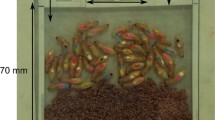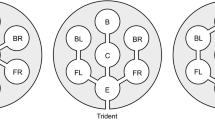Abstract
Social insects build sophisticated and complex architectures such as huge nests and underground galleries based on self-organizing rules. The structures of these architectures vary widely in size and shape within a species. Some studies have revealed that the current environmental and/or social factors can cause differences in the architectures that emerge from collective building. However, little is known about the effect of colony-level variations on the architecture. Here, we demonstrate that termite colonies build colony-specific architecture using shelter-tube construction as a model system. When we divided a colony into multiple groups of individuals, groups drawn from the same colony performed similar patterns of construction, whereas groups from different colonies exhibited different patterns. The colony variations in shelter-tube construction are generally thought to reflect differences in foraging strategy, and this difference can have important fitness consequences depending on the distribution of wood resources in the environment. This is the first demonstration of colony variation in the architecture that emerges from collective behavior. Colony-specific architectural variations provide new insights into our understanding of the self-organization systems, which were previously assumed to provide each species with a species-specific construction mechanism.



Similar content being viewed by others
References
Abe T. 1987. Evolution of life types in termites. In: Evolution and Coadaptation in Biotic Communities (Kawano S., Connell J. and Hidaka T., Eds), Tokyo Press, Tokyo, pp 125-148
Araújo A.P.A., de Araújo F.S. and De Souza O. 2011. Resource suitability affecting foraging area extension in termites (Insecta, Isoptera). Sociobiology 57: 271-284
Ben-Shahar Y., Robichon A., Sokolowski M. and Robinson G. 2002. Influence of gene action across different time scales on behavior. Science 296: 741-744
Bollazzi M., Kronenbitter J. and Roces F. 2008. Soil temperature, digging behaviour, and the adaptive value of nest depth in South American species of Acromyrmex leaf-cutting ants. Oecologia 158: 165-175
Bonabeau E., Theraulaz G., Deneubourg J.L., Aron S. and Camazine S. 1997. Self-organization in social insects. Trends Ecol. Evol. 12: 188-193
Buhl J., Deneubourg J.L., Grimal A. and Theraulaz G. 2005. Self-organized digging activity in ant colonies. Behav. Ecol. Sociobiol. 58: 9-17
Camazine S. 1991. Self-organizing pattern formation on the combs of honey bee colonies. Behav. Ecol. Sociobiol. 28: 61-76
Camazine S., Deneubourg J.L., Franks N.R., Sneyd J.,Theraulaz G. and Bonabeau E. 2001. Self-Organization in Biological Systems. Princeton University Press, Princeton
Cornelius M.L. and Osbrink W.L.A. 2010. Effect of soil type and moisture availability on the foraging behavior of the Formosan subterranean termite (Isoptera: Rhinotermitidae). J. Econ. Entomol. 103: 799-807
Crosland M., Ren S. and Traniello J. 1998. Division of labour among workers in the termite, Reticulitermes fukienensis (Isoptera: Rhinotermitidae). Ethology 104: 57-67
Crosland M.W.J. and Traniello J.F.A. 1997. Behavioral plasticity in division of labor in the lower termite Reticulitermes fukienensis. Naturwissenschaften 84: 208-211
Deneubourg J.-L. 1977. Application de l'ordre par fluctuations a la description de certaines étapes de la construction du nid chez les termites. Insect. Soc. 24: 117–130
Franks N., Wilby A., Silverman B.W. and Tofts C. 1992. Self-organizing nest construction in ants: sophisticated building by blind bulldozing. Anim. Behav. 44: 357-375
Franks N.R. and Deneubourg J.L. 1997. Self-organizing nest construction in ants: individual worker behaviour and the nest’s dynamics. Anim. Behav. 54: 779-796
Gordon D.M., Guetz A., Greene M.J. and Holmes S. 2011. Colony variation in the collective regulation of foraging by harvester ants. Behav. Ecol. 22: 429-435
Gotelli N.J. and Ellison A.M. 2004. A Primer of Ecological Statistics. Sinauer Associates, Sunderland
Haifig I., Jost C., Janei V. and Costa-Leonardo A.M. 2011. The size of excavators within a polymorphic termite species governs tunnel topology. Anim. Behav. 82: 1409-1414
Hansell M.H. 2005. Animal Architecture. Oxford University Press, Oxford
Ingram K.K., Oefner P. and Gordon D.M. 2005. Task-specific expression of the foraging gene in harvester ants. Mol. Ecol. 14: 813-818
Kaiser H.F. 1974. Index of factorial simplicity. Psychometrika 39: 31-36
Karsai I. and Penzes Z. 1993. Comb building in social wasps - self-organization and stigmergic script. J. Theor. Biol. 161: 505-525
Korb J. and Heinze J. 2004. Multilevel selection and social evolution of insect societies. Naturwissenschaften 91: 291-304
Leadbeater E. and Chittka L. 2007. Social learning in insects- from miniature brains to consensus building. Curr. Biol. 17: 703-713
Robinson G.E., Fahrbach S.E. and Winston M.L. 1997. Insect societies and the molecular biology of social behavior. Bioessays 19: 1099-1108
Scharf I., Modlmeier A.P., Fries S., Tirard C. and Foitzik S. 2012. Characterizing the collective personality of ant societies: aggressive colonies do not abandon their home. PLoS One 7: e33314
Shellman-Reeve J.S. 1997. The spectrum of eusociality in termites. In: The Evolution of Social Behavior in Insects and Arachnids (Choe J. and Crespi B., Eds), Cambridge University Press, Cambridge, pp 52-93
Theraulaz G. and Bonabeau E. 1995. Coordination in distributed building. Science 269: 686-686
Theraulaz G., Bonabeau E. and Deneubourg J.L. 1998 The origin of nest complexity in social insects. Complexity 3: 15-25
Theraulaz G., Bonabeau E., Nicolis S.C., Sole R.V., Fourcassié V., Blanco S., Fournier R., Joly J.L., Fernandez P., Grimal A., Dalle P. and Deneubourg J.L. 2002. Spatial patterns in ant colonies. Proc. Natl Acad. Sci. USA 99: 9645-9649
Toffin E., Di Paolo D., Campo A., Detrain C. and Deneubourg J.L. 2009. Shape transition during nest digging in ants. Proc. Natl Acad. Sci. USA 106: 18616-18620
Toffin E., Kindekens J. and Deneubourg J.L. 2010. Excavated substrate modulates growth instability during nest building in ants. Proc. R. Soc. B. 277: 2617-2625
Tschinkel W.R. 2004. The nest architecture of the Florida harvester ant, Pogonomyrmex badius. J. Insect. Sci. 4: 21
von Frisch K. 1975. Animal Architecture. Hutchinson, London
Wilson E.O. 1971. The Insect Societies. Harvard University Press, Cambridge MA
Wray M.K., Mattila H.R. and Seeley T.D. 2011. Collective personalities in honeybee colonies are linked to colony fitness. Anim. Behav. 81: 559-568
Yang R.L., Su N.Y. and Bardunias P. 2009. Individual task load in tunnel excavation by the Formosan subterranean termite (Isoptera: Rhinotermitidae). Ann. Entomol. Soc. Am. 102: 906-910
Acknowledgments
We thank Dr. Kazuya Kobayashi and Dr. Jin Yoshimura for helpful comments. This work was supported by the Japan Society for the Promotion of Science (No. 09001407) and by the Sumitomo Foundation to K. M.
Author information
Authors and Affiliations
Corresponding author
Rights and permissions
About this article
Cite this article
Mizumoto, N., Matsuura, K. Colony-specific architecture of shelter tubes by termites. Insect. Soc. 60, 525–530 (2013). https://doi.org/10.1007/s00040-013-0319-1
Received:
Revised:
Accepted:
Published:
Issue Date:
DOI: https://doi.org/10.1007/s00040-013-0319-1




